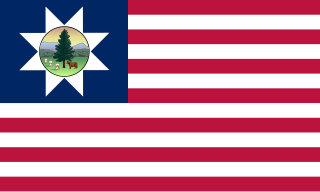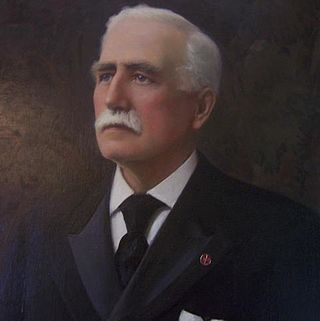
The Vermont National Guard is composed of the Vermont Army National Guard and the Vermont Air National Guard. Together, they are collectively known as the Green Mountain Boys. Both units use the original Revolutionary War-era Flag of the Green Mountain Boys as their banner. In 2009, they had 2,600 members.

The 1st Vermont Infantry Regiment was a three months' infantry regiment in the Union Army during the American Civil War. It served in the eastern theater, in and around Fortress Monroe, Virginia.

The 3rd Vermont Infantry Regiment was a three-years infantry regiment in the Union Army during the American Civil War. It served in the eastern theater, predominantly in the VI Corps, Army of the Potomac, from July 1861 to July 1865. It was a member of the Vermont Brigade.

During the American Civil War, the State of Vermont gave strong support to the Union war effort, raising troops and money. According to Rachel Cree Sherman:
By the spring of 1865 Vermont was devastated, having sent one tenth of its entire population to war, with a loss of over 5,000 lives to battle, wounds, and disease. The state had dedicated nearly $10 million to support the conflict, half of that amount offered up by towns with no expectation of recompense.

The 2nd Vermont Infantry Regiment was a three years' infantry regiment in the Union Army during the American Civil War. It served in the eastern theater, predominantly in the VI Corps, Army of the Potomac, from June 1861 to July 1865. It was a member of the famous Vermont Brigade.

Asa Peabody Blunt was an officer in the Union Army during the American Civil War. He remained on active duty after the war. In recognition of his service during the Civil War, he was appointed to the grade of brevet brigadier general of volunteers. Blunt was notable as commander of the 2nd Vermont Brigade and the United States Disciplinary Barracks at Fort Leavenworth, Kansas.

John Lester Barstow was an American teacher, farmer, politician, and soldier who served as the 39th governor of Vermont, United States.

The 2nd Vermont Brigade was an infantry brigade in the Union Army of the Potomac during the American Civil War.

The 12th Vermont Infantry Regiment was a nine months' infantry regiment in the Union Army during the American Civil War. It served in the eastern theater, predominantly in the Defenses of Washington, from October 1862 to July 1863. It was a member of the 2nd Vermont Brigade.

The 15th Vermont Infantry Regiment was a nine-months' infantry regiment in the Union Army during the American Civil War. It served in the eastern theater, predominantly in the Defenses of Washington, from October 1862 to August 1863. It was a member of the 2nd Vermont Brigade.

The 14th Vermont Infantry Regiment was a nine months' infantry regiment in the Union Army during the American Civil War. It served in the eastern theater, predominantly in the Defenses of Washington, from October 1862 to August 1863. It was a member of the 2nd Vermont Brigade.

William Wirt Henry was a manufacturer and a colonel in the Union Army during the American Civil War. He was a recipient of the brevet grade of brigadier general of volunteers and the Medal of Honor for gallantry in action.

The 16th Vermont Infantry Regiment was a nine months' infantry regiment in the Union Army during the American Civil War. It served in the eastern theater, predominantly in the Defenses of Washington, from October 1862 to August 1863. It was a member of the 2nd Vermont Brigade.

The 13th Vermont Infantry Regiment was a nine months' infantry regiment in the Union Army during the American Civil War. It served in the eastern theater, predominantly in the Defenses of Washington, from October 1862 to August 1863. It was a member of the 2nd Vermont Brigade.

Peter Thacher Washburn was a Vermont lawyer, politician and soldier. A veteran of the American Civil War, he served as the 31st governor of Vermont as a Republican from 1869 to 1870, and was the second Vermont Governor to die in office.

Urban Andrain Woodbury was an American Civil War veteran, an entrepreneur and a U.S. politician of the Republican Party. He served as mayor of Burlington, 37th lieutenant governor, and as the 45th governor of Vermont.

Farrand Stewart Stranahan was an American Civil War veteran, a railroad executive, a banker, and a U.S. politician of the Republican Party.

During the American Civil War in the mid-19th Century, the state of Vermont contributed five artillery units to the Union war effort.

Josiah Grout Jr. was an American lawyer and politician from Vermont. A Republican, he served multiple terms in the Vermont House of Representatives and Vermont Senate, including holding the leadership post of Speaker from 1874 to 1876 and 1886 to 1890. He served as governor from 1896 to 1898.

Lester Goodel Hack was an American soldier who fought in the American Civil War. Hack received his country's highest award for bravery during combat, the Medal of Honor. Hack's medal was won for his actions at the Third Battle of Petersburg in Virginia, where he captured the flag of the Confederate 23rd Tennessee Infantry on April 2, 1865. He was honored with the award on May 10, 1865.










